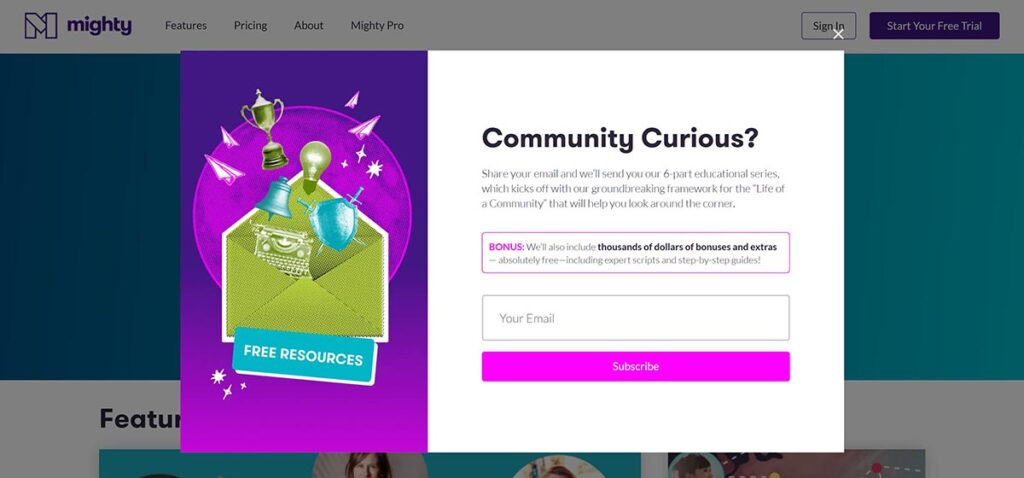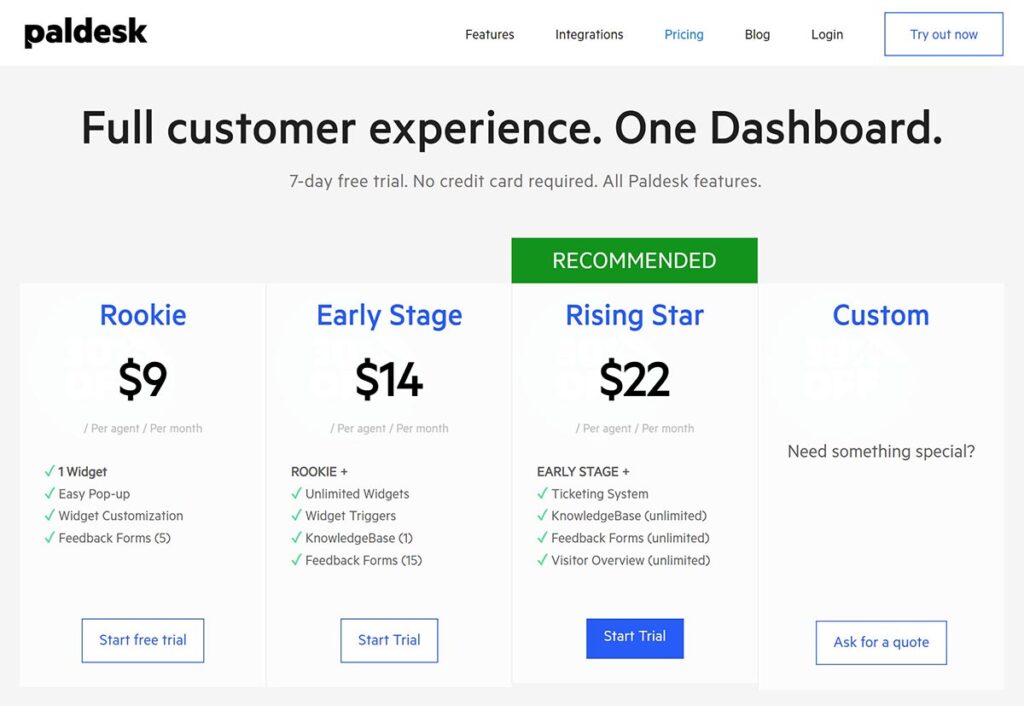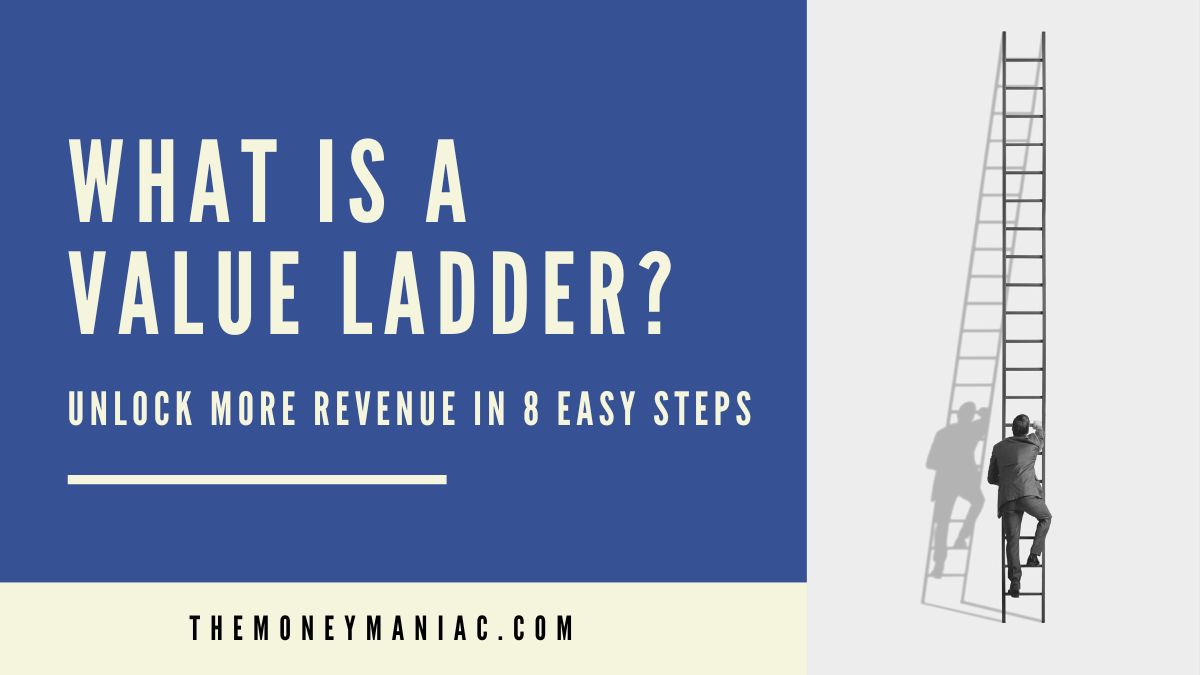Are you struggling to turn your business into a profitable, sustainable enterprise? Or perhaps you want to turn your idea into a product or service people are willing to pay for?
If so, don’t worry – there’s a powerful way to transform how you sell. Introducing… the value ladder! A value ladder is a tool that can help you understand and demonstrate how you create value for your customers. This will simple yet effective model can help you generate more leads, close more deals, and upsell your existing customer base.
In this article, we will take an in-depth look at what a value ladder is and how it works. And as you read, you will learn how to use it to transform your business, make more money, and achieve your goals. Let’s dive in!
What Is A Value Ladder?
A value ladder is a handy way of visualizing the different offerings that a business provides its customers. This approach takes a disorganized group of existing products and services and organizes them into tiers. Each tier clearly conveys the benefits your business delivers at a given service level and summarizes why customers receive a great value for that price.
When done correctly, the value ladder model of pricing should boost your bottom line. You will be better able to communicate the value-add of your business, which will allow you to close deals faster and make more money.
To get a better sense of a value ladder, imagine a traditional ladder. Each rung on this ladder will represent an additional increment in value provided to the customer.
At the lowest rung is a low-cost product or service that serves as an introduction to your business. And as customers move up the ladder, they purchase higher-priced products that offer more personalized attention or more valuable features.
Examples Of A Value Ladder In Action
Whether you realize it or not, you regularly come across value ladders in everyday life. Here are a few examples of businesses that use the value ladder system.
- Gyms: A gym may offer a basic membership at the bottom of its value ladder, which gives customers access to the facilities and equipment. At higher rungs of the ladder, however, customers can purchase additional services such as nutrition plans, group fitness classes, or personal training sessions.
- Software providers: If you have ever used a SAAS product, you may have noticed the various tiers of access and functionality. The most basic, limited version of the software is available for an approachable price. But if you need more advanced features, personalized support, or additional users you have to subscribe to a premium version of the software.
- Consulting firms: Whether you need social media marketing guidance, a new website design, or product development assistance, there is a consulting firm available to help. Typically, you can get a free report, ebook, or video series at the base level. Next, you may be able to pay for a basic consultation without breaking the bank. But at the top of the value ladder, you can invest in done-for-you packages, one-on-one training sessions, and more.
- Online courses: Digital creators often leverage value ladders to segment their audience and monetize their content. They will usually offer a basic version of a course for cheap, which lets customers get a taste of what it’s like to work with them. If the user likes the experience, they may invest in more complete versions of the course. And after completing that content, creators may then offer personalized mentorship or group coaching at a much higher price point.
By now, you likely recognize a value ladder that you have interacted with in your own life. And hopefully, your mind is starting to spin with ideas for your own business.
If you haven’t made use of this powerful sales technique yet, it is worth testing. As read on, consider the many ways this concept can help you generate more value from your existing clientele.
The Benefits Of A Value Ladder In Your Business
Based on the examples above, you may already see the reasons to use a value ladder in your business. From product development to customer segmentation, this pricing strategy can offer a wide variety of advantages.
Here are a handful of the most important benefits:
- Better understand how to create value for customers and how to price your offerings accordingly
- Create clear upsell and cross-sell opportunities for your existing customers
- Demonstrate to your sales team the different levels of value your product range offers
- Help the sales team communicate with new prospects
- Allow leads to match their needs and budget with the appropriate product
- Overcome objections visually by showing where your service offers greater value than competitors’ services
- Facilitate customized packages for customers who need to combine features, services, and benefits from different parts of the value ladder
- Increase the average transaction value by encouraging repeat customers to move up the ladder to higher-priced options
As you can see, there are many benefits to using the value ladder model in your business. The key is to understand how to create maximum value for your customers and then use that value to craft an effective pricing structure. This can help take your business to the next level and maximize customer satisfaction and loyalty.
How To Create A Value Ladder For Your Business
Building an effective value ladder requires careful thought and planning. But if you are ready to apply a value ladder in your business, here are the 8 key steps to follow:
1) Identify your target audience
The first step in creating a value ladder is identifying with your target audience and immersing yourself in their needs, wants, and desires. To start, gather data from analytics platforms, customer surveys, and previous feedback.
As you think about their demographics, try to create a thorough persona of your ideal customer. Include relevant details like:
- Age
- Gender
- Education level
- Occupation
- Income bracket
- Location
- Goals and challenges
- Interests
- Values
Next, use online research tools like Google Trends and Quora to identify emerging behaviors. Consider the way people in your target demographic interact with products, services, and technology. And look for inflection points, or opportunities to disrupt the existing market. Any angle you can find will help inform how you can offer value to these potential customers.
2) Create a complete list of your products and services
Once you have learned about your ideal prospects, focus on linking their needs to your solutions. To do this, create a complete list of your products and service offerings.
Brainstorm where you can offer value, and add this to the list. But remember that this can be functional value (i.e., solving a problem), emotional value (i.e., making someone feel better), or social value (i.e., helping someone fit in). The goal at this stage is to enumerate every benefit you currently provide, or could provide in the future.
As an example, envision that you run a coaching or consulting business. Here are many of the different services or products you may be able to offer:
- Webinars: These provide prospects with information on how to resolve a pain point, and position you as an expert.
- Ebooks: Helpful, targeted content can be used to generate leads and establish trust.
- Group coaching: An affordable way for customers to receive personalized attention and enjoy the benefits of community discussion.
- Zoom events: A real-time online meetup that engages, motivates, and informs people. Also, provides an opportunity for attendees to get their questions answered.
- In-person events: An even more impactful way to coach people and facilitate community building with other attendees.
- Online courses: These enable customers to consume content independently and on their own schedule. It also allows you to educate an unlimited number of people from all around the world.
- Exclusive online communities and forums: A means to connect your prospects and leads and drive relevant discussions. These can provide value by simply aggregating like-minded people on similar journeys.
- One-on-one coaching sessions: This high-ticket offering is an ideal way to deliver personalized value and ensure your clients reach their goals.
- Customized solutions: For those with complex needs and significant budgets, a tailored approach can be the most powerful option.
3) Break your list into different tiers
Once you have a complete picture of where you can add value for prospects, separate these products or services into distinct groups.
To continue with the coaching example, here is a potential starting point:
- Generate leads by offering your ebooks and pre-recorded webinars for free
- Promote a one-time sale on your online courses to these leads
- Upsell these customers into a mentorship program that includes a close-knit community of successful students
- Offer your mentorship clients a package of 1:1 coaching calls for more personalized assistance
This tiering approach represents the beginnings of your value ladder. It allows you to map out the different depths your customers can reach within your company, and ensures that every customer has an appropriate solution for their budget or needs.
But remember, value ladders are meant to be scalable over time. You can start with a few tiers and gradually add more as your business grows and you uncover new needs in the market.
4) Hook prospects with a “no-brainer” offer
Now that you have a sense of the value you provide at each tier, it’s time to make those packages irresistible! To maximize the number of leads available to ascend your ladder, start with a “no-brainer” offer.
This type of offer is a low or no-cost solution that wows your prospects and leaves them eager to try more of your services. Think of it as a win-win: you create an amazing first impression, and your customer gets great value.
“No-brainer” offers can take many forms. Here are a few ideas:
- Free 30-minute consultation: This provides a taste of what 1:1 coaching sessions are like, and can quickly turn interested prospects into paying clients.
- Free monthly webinar: Give people an opportunity to interact with you, learn valuable information on a specific topic, and get to know your teaching style.
- Discounted online course: Provide an introductory price for a limited time to give people an incentive to try out your content.
- Free ebook or resources: Give away helpful information that demonstrates your expertise. Mighty Networks uses this option to hook leads in with a 6-part educational series worth thousands of dollars.

These offers can be used to drive traffic to your website, create excitement around new products or services, or just introduce prospects to your brand. However you use them, the key is to make a splash and get noticed. Once you have prospects’ attention, use the tiers of your value ladder to guide them toward higher-priced offerings.
5) Determine the price points for each rung
As you design each tier of your value ladder, keep in mind the potential prices you can charge. Use the value you’re providing as a reference point, and don’t be afraid to experiment with different price points.
As a rule of thumb, start with the lowest rung on your value ladder and work your way up. Price the first product or service so that it’s attractive enough to entice people, but still makes it worth your while. From there, keep in mind your target audience’s budget and how significant of a problem you’re solving for them. Are you saving them time? Improving their confidence? Or teaching a monetizable skill?
These factors should all be taken into account when pricing each tier. Try to strike a balance between what the market will bear and what you believe your services are worth.
In the coaching example, let’s say you decide to give away your ebook in exchange for an email address. First, create an opt-in popup form on your website and set up an autoresponder that delivers the ebook when your prospects sign up.
Next, you can enter these leads into an email automation that nudges them toward a $37 seminar on how to land more clients for their small business. From there, you can offer them a $297 monthly membership into your community of fellow business owners and growth hackers.
Finally, you may price your top-tier package of 1:1 coaching calls at $1,000 per hour. If you feel that you can transform the lives of your clients and you have a limited amount of time available, this seemingly high price may actually be just right. Members in your community may be able to justify the cost if you can help them to generate more revenue, position their business more competitively, or pivot into a more rewarding industry.
6) Create a visual representation of your value ladder
Once you have all the pieces in place, it’s time to create a visual representation of your value ladder. You can do this for internal reasons — for your own marketing and sales team. Or, you can prepare value ladders in diagram form for your customers and clients.
Your value ladder could be a simple diagram, a detailed infographic, or a product list on your pricing page. The key is to make it easy for customers to understand what each level of your value ladder offers and how much it costs. And don’t forget to include the “no-brainer” offers you have created! The final visual should make it easy for customers to understand where your business adds value and how they can move forward.

7) Utilize your value ladder everywhere
Once your value ladder is built out, start using it everywhere — from blog posts, emails, and sales pages to marketing materials like brochures, flyers, and banners. This will help you build brand recognition, move prospects through your funnel, and ultimately drive more business.
By implementing a value ladder, you can provide customers with an easy-to-understand range of products and services that meets their needs. This not only helps you maximize your revenue but also establishes trust with customers because they know that you have something for everyone.
And if you feel that certain segments of your audience could benefit from more tailored offers, you can always create mini-value ladders that focus on specific customer needs. This is a great way to ensure that every one of your prospects gets the most value out of what you have to offer.
8) Test and refine your value ladder
As you promote your value ladder, keep in mind that it’s always a work in progress. You may find that certain tiers of your ladder are more successful than others, or that customers don’t understand the language you use to describe your offers.
Be sure to pay attention to customer feedback and make adjustments as necessary so that your value ladder remains effective. You may also want to experiment with new offers or adjust the pricing of existing tiers to find the sweet spot that works best.
Consider tracking the results of each new iteration of your value ladder, so you can easily identify the performance of each change. This will help you slowly optimize your value ladder to maximize the results it yields, in terms of both profit and customer satisfaction.
By continually testing and refining your value ladder, you can ensure that it effectively communicates the value you offer to your customers and helps you achieve your business goals.
Applying The Value Ladder To Sales
A value ladder is much like a sales funnel. Value ladders lead customers toward higher-value services, and sales funnels lead prospects toward an initial sale.
Sales funnels provide a framework for understanding the different stages of the customer journey. And they typically consist of the following stages:
- Awareness
- Interest
- Decision
- Action

The value ladder is closely linked to the decision and action stages of the sales funnel. To link your marketing or sales funnel with your value ladder, follow this simple guide:
How to link your sales funnel to the value ladder
Connecting your sales funnel and value ladder is all about positioning and framing your offers in the right way. Start by creating a flow of experiences that leads prospects from awareness to purchase.
1. Awareness
In this stage, you must identify your target market and provide content that resonates with them. Give prospects an incentive to learn more about your business and what you have to offer.
A few methods to build awareness include:
- SEO: Optimize your website for search engines so customers can find your brand in the Google, Bing, or Yahoo search results.
- Social media marketing: Leverage social media platforms such as Instagram, Facebook, and Twitter to reach your target audience.
- Content marketing: Create content such as blog posts, videos, webinars, ebooks, and more to educate your potential customers about your products and services.
2. Interest
Once you’ve established awareness, it’s time to engage prospects by showing them what you have to offer. Present prospects with offers tailored to their needs, and explain why your products or services are the best solutions for them.
A few methods to generate interest include:
- Advertising: Use pay-per-click ads, banner ads, or other forms of digital advertising to reach your target market and draw their attention to your offers.
- Live events: Participate in live events such as conferences, expositions, and workshops to promote your offerings to a wider audience.
- Email marketing: Send out regular emails with offers and updates that highlight the features and benefits of your products and services.

3. Decision
At this stage, customers decide whether they want to buy your products or services. A few methods to encourage customers to make a purchase include:
- Free trials: Offer potential customers a free trial, so they can experience all the features your products have to offer.
- Teaser campaigns: Launch teaser campaigns to create anticipation and excitement around the launch of your new products or services.
- Testimonials: Share customer reviews and testimonies to build trust with prospects.
- Exclusive offers: Offer exclusive deals or discounts to customers who decide to buy.
Here is where you can begin to use your value ladder to communicate the difference between your various offerings. Explain why customers should choose you over the competition and emphasize the benefits they will get from making a purchase.
Outline the difference between each tier of the value ladder, such as the features, benefits, and prices associated with each option. To simplify this, you may consider using tiered pricing, bundling products and services together, or allowing customers to choose their own package.
4. Action
Finally, it’s time to convert prospects into customers. Make sure the buying process is as straightforward as possible, so customers can take action without any issues.
To encourage your prospects through this last step:
- Create urgency: Use tactics like limited-time offers and countdown timers to encourage customers to act quickly.
- Incentives: Offer incentives such as free gifts or discounts to push customers to make a purchase.
- Calls to action: Implement strong calls to action to direct your prospects to take the desired step and complete checkout.
With a few gentle pushes, you can convert your leads into customers and begin leading them to higher rungs on your value ladder.
5. Retention
Retention is all about maintaining relationships with your existing customers and encouraging them to make repeat purchases. This is where you can find those customers who are candidates for your high-ticket packages and begin to demonstrate the value of those offerings.
Here are three simple ways to increase customer retention:
- Customer loyalty programs: Create a rewards program that gives customers incentives to keep buying from you.
- Personalized offers: Use data from previous purchases to create personalized offers that cater to each customer’s interests and needs.
- Follow-up emails: Send follow-up emails to customers after their purchase to thank them, ensure they’re satisfied, and encourage them to return.
By marrying the sales funnel and the value ladder, business owners can generate leads, convert them to customers, and maximize revenue. To do this, however, brands must first focus on creating as much value as possible for every different type of customer.
This is where a value ladder can help you develop and communicate a full range of offerings.
With a streamlined approach, you can target and nurture each customer as they move up the ladder of value. From awareness to retention, this model is an effective way to drive more sales and greater customer satisfaction at the same time.
Final Thoughts
A value ladder is a powerful tool that can help you maximize the value of your business. By mapping customer needs to various pricing and service tiers, you can present your customers with a range of options and ensure they get the right product or service for their budget.
Plus, as you deliver at each stage of the customer journey, you can guide your customers up the value ladder to premium packages. Over time, this will result in greater customer satisfaction, a higher average order value, and more total revenue.
So don’t wait to apply the value ladder concept in your own business. It may be just what you need to take your offering to the next level and unlock further growth. Good luck!



